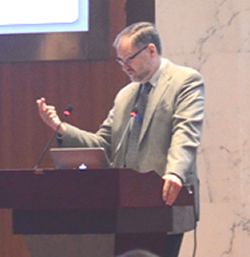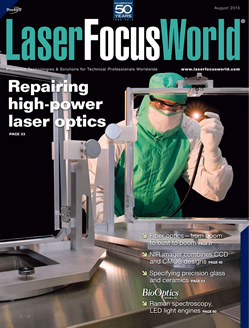Papers and Presentations - 2015
August
Simulations Help in Repairing Optics Damage
‘Nexawatt’ Lasers Discussed at Ultrafast Optics Conference
A strategy for developing the next generation of ultra-high-energy laser systems—capable of delivering one quintillion (1018) watts of power—was outlined by NIF & Photon Science Chief Technology Officer Chris Barty on Aug. 18 at the tenth Ultrafast Optics conference near Beijing, China.
 Chris Barty during his presentation at the Ultrafast Optics conference.
Chris Barty during his presentation at the Ultrafast Optics conference. In an invited talk titled, “Nexawatt: Strategies for Exawatt Pulse Generation with Modern High Energy Lasers,” Barty reviewed novel concepts that would leverage the existing NIF infrastructure to produce exawatt and beyond peak-power laser pulses. An exawatt is 1,000 times more energy than a petawatt, currently the highest energy level ultrafast laser systems are capable of producing.
Barty said the Nexawatt path to an exawatt laser involves the combination of a novel pulse-compression architecture, mixed-material preamplifiers, and a mixture of chirped-pulse and chirped-beam amplification. Chirped beam amplification is an LLNL-patented concept in which the pulse spectral content is distributed in space, effectively producing a longer-duration pulse which may be amplified without damage in large-scale, NIF-like amplifiers. Unlike existing systems, the Nexawatt concept enables safe extraction of the full stored energy of the amplifier.
The Ultrafast Optics meeting had more than 200 attendees and spanned five days. The biennial meeting series is devoted to discussion and presentation of the latest research involving generation, amplification and measurement of ultrashort duration laser pulses. Barty, a member of the conference advisory board, said LLNL has had a strong role in the evolution of the Ultrafast Optics conference. Barty, then at UC San Diego, co-chaired the first meeting in 1997 in Monterey, California, along with Bill White, then in LLNL’s Physics Directorate.
Simulations Help in Repairing Optics Damage
One of the major challenges of operating high-energy laser systems such as NIF is mitigating laser damage to the silicon dioxide (SiO2) fused-silica optics used in the system. High irradiance levels near the laser damage threshold of  the optics can create small pits in an optic’s surface “similar to the ding you get when a rock hits your car’s windshield,” said LLNL physicist Ibo Matthews, “but a lot more expensive.”
the optics can create small pits in an optic’s surface “similar to the ding you get when a rock hits your car’s windshield,” said LLNL physicist Ibo Matthews, “but a lot more expensive.”
In the cover article in the August issue of Laser Focus World, Matthews describes how LLNL researchers used COMSOL Multiphysics, a software tool for modeling and simulating physics-based problems, to study techniques for repairing and recycling damaged optics.  Laser-system optics can be damaged from repeated exposure to high-peak-power laser pulses: (left panels) damaged optic surface; and (right panels) repaired, or mitigated, site. The upper panel shows the result of a “slow annealing” process, while the lower panel shows a “rapid microshaping” technique currently employed at NIF. Several repair techniques have been developed at LLNL with the aim of extending the useable life of the optics.The simulations included heat transfer in fluids, chemical reactions, and structural mechanics, as well as mass transport and fluid flow. Matthews’ research team worked side-by-side with a development group led by Isaac Bass, John Adams and Mike Nostrand, who ultimately produced working protocols suitable for a production environment.
Laser-system optics can be damaged from repeated exposure to high-peak-power laser pulses: (left panels) damaged optic surface; and (right panels) repaired, or mitigated, site. The upper panel shows the result of a “slow annealing” process, while the lower panel shows a “rapid microshaping” technique currently employed at NIF. Several repair techniques have been developed at LLNL with the aim of extending the useable life of the optics.The simulations included heat transfer in fluids, chemical reactions, and structural mechanics, as well as mass transport and fluid flow. Matthews’ research team worked side-by-side with a development group led by Isaac Bass, John Adams and Mike Nostrand, who ultimately produced working protocols suitable for a production environment.
“Initially, our (optics damage) research focused on the underlying physics and material science of how fused silica behaves when exposed to far-IR (infrared) laser light at varying temperatures using finite element code developed at the lab,” Matthews said in the article. He eventually turned to the multiphysics simulations “to explore specific techniques for repairing the damaged optics beyond our initial study and to get a hands-on feel for what was going on.” His team used simulation to better understand laser-material interactions associated with three techniques for repairing damaged optics: infrared pulsed laser microshaping/micromachining, slow annealing, and laser chemical vapor deposition (L-CVD).
“Despite the long history of IR-laser processing of silica optics,” Matthews said, “few attempts have been made to understand the energy coupling and heat flow to optimize the process. We were able to answer many of these questions by simulating a wide range of laser parameters and material properties. Results from the simulations for temperature and material behavior in target zones compared well with the team’s experiments. What we learned in our research can be applied beyond the repair of damage in our high-energy, pulsed-laser systems to virtually any system that requires laser polishing, annealing, and microshaping of silica surfaces.”



